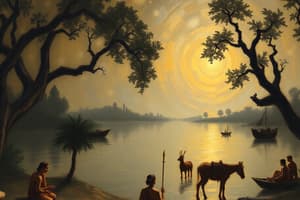Podcast
Questions and Answers
What was the role of the home as a center of education in ancient India?
What was the role of the home as a center of education in ancient India?
Homes served as a place of learning where family members were the first teachers, instilling basic values, moral duties, and religious practices.
What was the Gurukul system of Indian education?
What was the Gurukul system of Indian education?
The Gurukul system involved a residential setup for students and teachers where holistic education was provided, covering subjects like Vedas, philosophy, and practical skills.
What was the Pathshala system of Indian education?
What was the Pathshala system of Indian education?
Pathshala was a community-based model of elementary education, emphasizing basic literacy and practical skills, adjusted to local needs.
What was Nalanda University known for?
What was Nalanda University known for?
What significance did Takshashila University have in ancient India?
What significance did Takshashila University have in ancient India?
Flashcards
Ancient Indian Home Education
Ancient Indian Home Education
Early childhood learning in ancient India took place in the home, with parents teaching children values, traditions, and basic skills.
Gurukul System
Gurukul System
Ancient residential boarding schools in India. Combining academic, spiritual, and practical learning focusing on values like humility and discipline, offered individual instruction.
Pathshala System
Pathshala System
Community-based elementary schools in ancient India, often in temples or homes. Provided basic literacy, numeracy and practical skills.
Nalanda University
Nalanda University
Signup and view all the flashcards
Takshashila University
Takshashila University
Signup and view all the flashcards
Early Childhood Education
Early Childhood Education
Signup and view all the flashcards
Gurukul Teacher
Gurukul Teacher
Signup and view all the flashcards
Pathshala Teachers
Pathshala Teachers
Signup and view all the flashcards
Nalanda Curriculum
Nalanda Curriculum
Signup and view all the flashcards
Takshashila Courses
Takshashila Courses
Signup and view all the flashcards
Study Notes
Ancient Indian Education System
- Homes were the primary centers of education in early life, teaching basic values, religious practices, and traditions.
- Family members, including parents, were the first teachers.
- Home education included study of scriptures like the Vedas and Upanishads for upper classes.
- Women received education at home, focusing on household duties, music, and arts.
Gurukul System
- Gurukuls were residential boarding schools with teachers (gurus) and students (shishyas).
- Holistic education emphasized academics, spirituality, and practical skills.
- Subjects included Vedas, Philosophy, Mathematics, Astronomy, Arts, and physical education (Yoga & Martial Arts).
- Guru-disciple relationship was crucial, stressing respect, dedication, and mentorship.
Pathshala System
- Pathshalas were community-based elementary schools existing before British rule.
- Education focused on basic literacy, numeracy, and practical skills.
- Tools like chalk, slate, or sand were used for learning.
- Curriculum included literature from religious texts and stressed moral education.
- Education emphasized individualization by tailoring it to each student.
Nalanda University
- Nalanda University was a prominent ancient center of learning, flourishing from the 5th to 12th centuries.
- It attracted students from various parts of Asia (China, Korea, Tibet).
- The curriculum included Buddhist philosophy, Vedic studies, mathematics, astronomy, medicine, and arts.
- A large library—Dharma Gunj—housed a vast collection of scholarly texts.
Takshashila University
- Takshashila was a significant ancient learning center located in modern-day Pakistan.
- Flourished from the 6th century BCE to the 5th century CE.
- Major trade routes facilitated student influx.
- Offered Vedic literature, philosophy, mathematics, medicine, astronomy, and military science.
- Famous scholars, including Chanakya and Panini, were associated with the university.
Studying That Suits You
Use AI to generate personalized quizzes and flashcards to suit your learning preferences.
Related Documents
Description
Test your knowledge on the ancient Indian education systems, including the Home education, Gurukul, and Pathshala models. Explore the methods, subjects taught, and the role of teachers and students in these educational practices. Dive into the richness of the educational traditions in ancient India!




